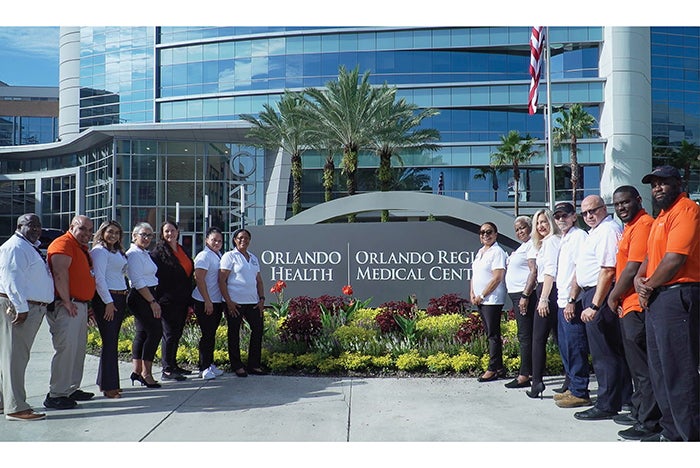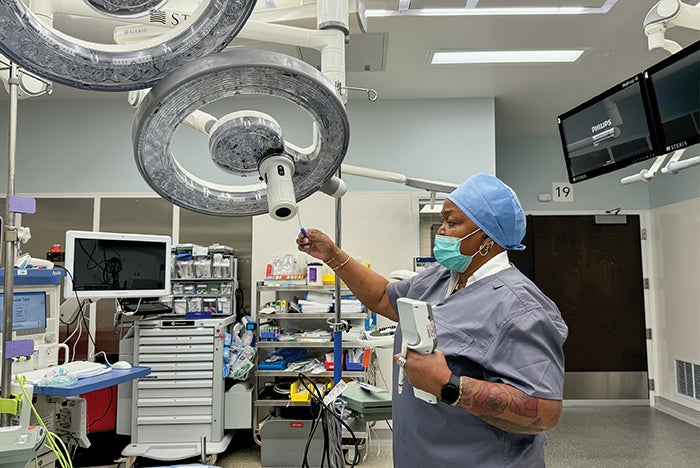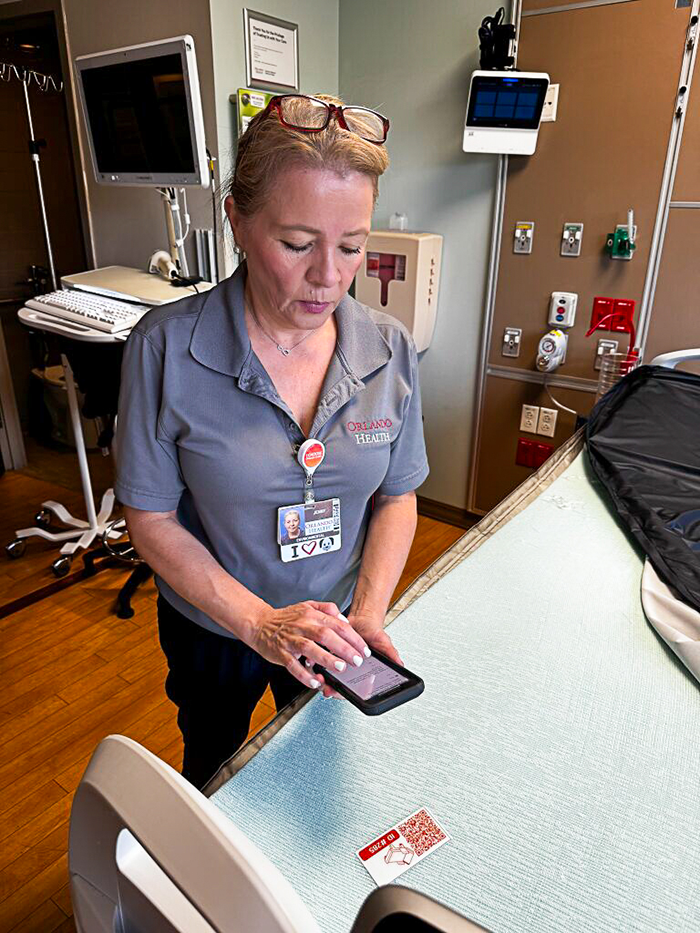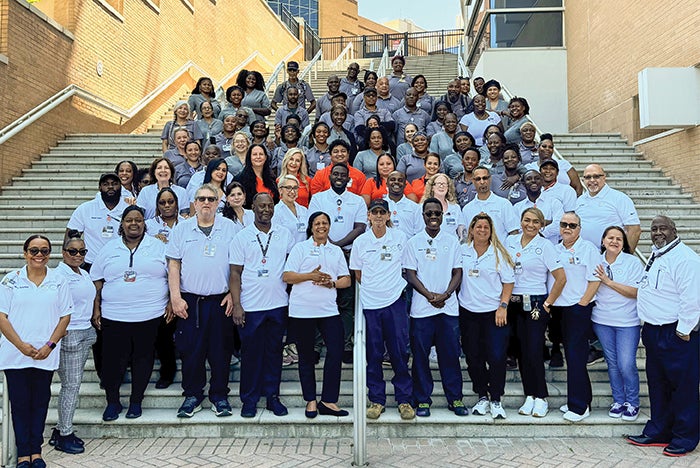2024 EVS Department of the Year: Orlando Regional Medical Center

FROM LEFT: Orlando Regional Medical Center environmental services department leaders Michael Parker, director; Adam Martinez, allied supervisor; Luz Martinez, training coordinator; Fiamin Cabrera, regulated waste and sustainability coordinator; April Lewis, operations manager; Maria Dumond, operations manager; Rufina Philip, EVS senior coordinator; Marcia Richardson, administrative assistant; Jean Pamphile, EVS trainer; Vittoria Panzardi, furniture coordinator; Robin Bonney, equipment and supply technician; Edwin Mendez, outer buildings and grounds; Alexander Reid, patient tower supervisor; and Immanuel Enslow, linen senior coordinator.
Image courtesy of Orlando Regional Medical Center
Many top hospital environmental services (EVS) departments are ambitious, but few can match the ambition found in the EVS department at Orlando (Fla.) Health — Orlando Regional Medical Center (ORMC).
For example, the department is constantly collaborating with multiple clinical and infection prevention units. One project was to determine the rate of microbiological contamination of privacy curtains. As a result, the hospital is removing cubicle curtains from non-essential areas and private rooms.
“The results [of the research study] were alarming,” says Michael Parker, CMIP, T-CHEST, T-CNACC, T-CSCT, director of EVS at ORMC.
Another project the department participated in was a clinical trial for highlight wipes, which show disinfection coverage. That study now has advanced to Phase 2, which involves the EVS department working with the highlight wipes’ scientists to develop a new version of the wipes that will be able to incorporate hydrogen peroxide.
This type of in-depth involvement with research is one reason Parker’s department does so well in the Association for the Health Care Environment’s (AHE’s) EVS Department of the Year Award program. Its win this year is its second in three years.
Keeping it safe
Parker believes a key element of being a top-performing EVS department is a clear focus on creating a safer environment in the hospital.
Among the initiatives the department has undertaken in that regard is the use of a UV-C light disinfection “robot” that disinfects spaces with no chemicals or fumes.
“We are also currently evaluating autonomous robots and autonomous floor scrubbers,” Parker says. “I believe we all can do good for our patients and our team members by creating a safer environment and a safer earth.
“We’ve been on a quest to look at things that are better for our team members, our patients and our guests, whether it be chemicals, new products, sustainability and sustainable products, linens, chemicals or further advancements in ultraviolet technologies,” Parker continues. “We dove deeply into these innovations and are considering the benefits that each can contribute to make our environment better and safer.”
Retention success
“Our quest, or our goal, is to be the best,” Parker says. “In addition to research and innovation, we perpetuate the growth of our team members by offering AHE certifications in Certified Health Care Environmental Services Technician, Certificate in Non-Acute Care Cleaning and in Certification Surgical Cleaning Technicians and have increased our team members’ living wage.
“We are intentional about successful team member engagement and offering rewards and promotions to high achievers within EVS and in other departments throughout the hospital, along with innovative benefits and programs,” Parker adds. “The investment in our team members along with the aforementioned programs have resulted in a reduction in our turnover rate by 9.98%.”
The hospital system is growing, which means opportunities for advancement continually emerge. The department created a career ladder that offers a roadmap for workers who want to move up to coordinator, trainer, supervisor, manager or other leadership positions. Creating the ladder was a two-year project that went into effect last summer.

Jean Pamphile, EVS trainer, conducts adenosine triphosphate testing in the hospital’s main operating rooms to ensure safe environments for patients in surgery.
Image courtesy of Orlando Regional Medical Center
“I think people leave when they feel like they’re in a dead-end position or there’s no room for growth,” Parker says. “So, if you continue to develop and grow your team members, then they can take on the positions you have in your department. I’m appreciative to our senior leadership at ORMC for really supporting that and allowing us to double down on it.”
Another human resources effort that has paid off is free education. In addition to training that is specific to their jobs, the health system covers the costs for employees who want to complete their GEDs, learn English or attend college. To date, 30 EVS staffers have achieved their GEDs, and four have started college.
Sustainability initiatives
The ORMC EVS department also has done well in the sustainability area. In 2021, it launched a five-year initiative to decrease landfill waste by 1% each year and increase recyclables by 1% each year.
One way it has reached that goal is by installing equipment that manufactures sodium hydroxide and hypochlorous acid, which are key chemicals in the cleaning system that the department has implemented. The in-house manufacturing saves money and reduces packaging.
Annually, ORMC has been saving tens of thousands of pounds of packaging for disinfection wipes and plastic bottles for disinfectants and floor, glass, bowl and bath cleaners.
Expanding responsibilities
The success of Parker’s department has led to increased responsibilities. For example, about a year ago, it began procuring beds and other furniture for the hospital and making sure it meets The Joint Commission standards. Previously, those purchases were handled by individual units or design teams.

Jenny Martinez, EVS tech lV, conducts mattress inspections during discharge cleaning to ensure patient safety and Joint Commission compliance.
Image courtesy of Orlando Regional Medical Center
Now, when someone needs furniture, they contact the EVS department, which places and tracks the order. When the furniture arrives, it is tagged with a QR code. The codes allow the department to catalog each piece of furniture and keep detailed data about maintenance and inspections, which makes The Joint Commission visits easier.
The department’s discharge technicians carry extra QR tags so they can tag mattresses that need inspection, ensuring that failed mattresses are changed out.
“For the first time in history, we know where every piece of furniture is,” Parker explains. “We’re also now pushing it out to other hospitals in the system. The quality team really likes it because it helps track a lot of stuff.”
Parker also reports that his department regularly evaluates, writes and amends its policies to maximize the effectiveness of this innovative technology.
Receiving recognition
The success of the ORMC EVS department has been recognized throughout the Orlando Health system and the United States.

Several Orlando Regional Medical Center environmental services team members take a few moments to commemorate the news that the hospital won the Association for the Health Care Environment’s EVS Department of the Year Award in the 500-plus beds category..
Image courtesy of Orlando Regional Medical Center
“We really have started to be looked at as a trusted adviser and as being highly reliable for our customers, whether they be internal or external,” Parker says.
“It is really a team effort — our team is a group of caring people who want to see things better,” he continues. “And so, as our doctors and nurses provide great quality outcomes, so does the EVS department at ORMC.”
Ed Avis is a freelance writer based in Chicago.



